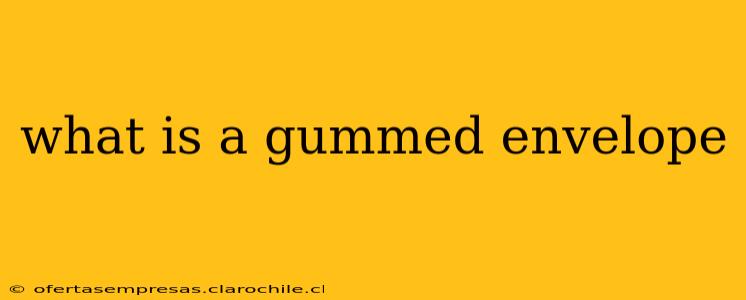A gummed envelope is a type of envelope that features a strip of gum or adhesive along one edge, typically the flap. This adhesive is designed to seal the envelope shut once it's been filled and folded. Unlike self-sealing envelopes, which have a pressure-sensitive adhesive already activated, gummed envelopes require moistening the gummed strip before it will adhere. This traditional method offers a distinct tactile experience and often a stronger seal, particularly when dealing with heavier contents or when mailing items that need extra security.
How Does a Gummed Envelope Work?
The gumming process involves applying a water-soluble adhesive to the envelope's edge during manufacturing. This adhesive is usually dextrin-based, a type of starch-derived glue. When water is applied, the dextrin dissolves and activates the adhesive, allowing the flap to securely stick to the envelope body.
What are the Advantages of Using Gummed Envelopes?
- Stronger Seal: Gummed envelopes often provide a more secure seal compared to self-sealing envelopes, especially for heavier or valuable contents. The adhesive bond tends to be more robust and less prone to accidental opening.
- Traditional and Secure: They offer a classic and reliable method of sealing mail, adding a level of security not always present with simpler closure mechanisms.
- Cost-Effective: Gummed envelopes can be a more economical option, particularly for high-volume mailing needs. They are often cheaper than self-sealing envelopes, although the cost savings are reduced if you consider the time needed to moisten each envelope.
- Environmentally Friendly (Potentially): Depending on the manufacturing process and the specific adhesive used, gummed envelopes can be more environmentally friendly than some self-sealing varieties. Look for those made from recycled paper with water-based adhesives.
What are the Disadvantages of Using Gummed Envelopes?
- Time-Consuming: The need to wet the adhesive strip before sealing adds extra time to the mailing process, particularly for large quantities.
- Messy: Moistening the gum strip can be messy, especially if not done carefully. There's a risk of getting glue on your fingers or the contents of the envelope.
- Requires a Moistening Agent: You need a wet sponge, a moistened finger, or a licking device (although licking is generally discouraged for hygiene reasons) to activate the adhesive.
- Storage Sensitivity: Gummed envelopes are more sensitive to humidity and temperature changes than self-sealing envelopes. Improper storage can lead to the gum drying out and becoming unusable.
What are the Different Types of Gummed Envelopes?
While the basic principle remains the same, gummed envelopes come in various sizes, shapes, and colors, catering to different mailing needs. Some may have different types of gumming, with variations in the strength and drying time of the adhesive. You'll often find them in standard sizes, like #10, but also in specialized shapes for specific uses.
Where Can I Find Gummed Envelopes?
Gummed envelopes are widely available from office supply stores, online retailers, and some stationery shops. They are commonly purchased in bulk for larger mailings. You'll usually find them next to other traditional mailing supplies.
Are Gummed Envelopes Still Relevant Today?
Despite the prevalence of self-sealing envelopes, gummed envelopes maintain relevance, especially in situations where security and a strong seal are paramount. They remain a viable option for businesses and individuals who prioritize these aspects of mailing. Their cost-effectiveness and traditional feel also contribute to their continued use.
